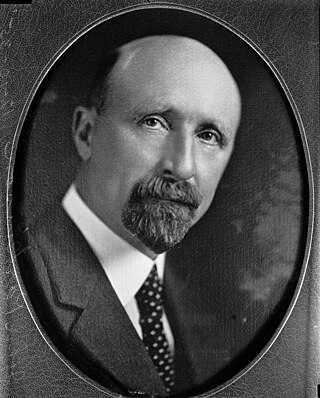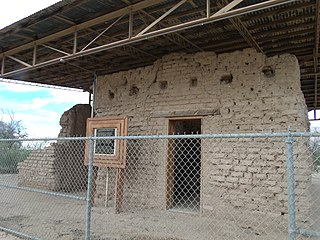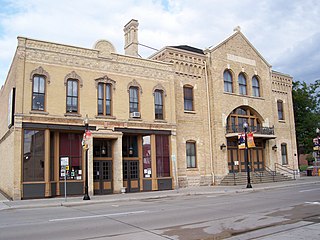Related Research Articles

Tucson is a city in and the county seat of Pima County, Arizona, United States, and is home to the University of Arizona. It is the second-largest city in Arizona behind Phoenix, with a population of 542,629 in the 2020 United States census, while the population of the entire Tucson metropolitan statistical area (MSA) is 1,043,433. The Tucson MSA forms part of the larger Tucson-Nogales combined statistical area. Both Tucson and Phoenix anchor the Arizona Sun Corridor. The city is 108 miles (174 km) southeast of Phoenix and 60 mi (100 km) north of the United States–Mexico border.

Catalina Foothills is an unincorporated community and census-designated place (CDP) located north of Tucson in Pima County, Arizona, United States. Situated in the southern foothills of the Santa Catalina Mountains, Catalina Foothills had a population of 50,796 at the 2010 census.

John and Donald Parkinson were a father-and-son architectural firm operating in the Los Angeles area in the early 20th century. They designed and built many of the city's iconic buildings, including Grand Central Market, the Memorial Coliseum, and City Hall.

Jules Jacques Benois Benedict was one of the most prominent architects in Colorado history, whose works include a number of well-known landmarks and buildings listed on the National Register of Historic Places.
Henry O. Jaastad (1872–1965) was an influential Tucson, Arizona architect. His firm created over 500 buildings and Jaastad was Mayor of Tucson for 14 years. A number of his works are listed on the U.S. National Register of Historic Places for their architecture.

CSHQA is a full-service design firm in the western United States specializing in architecture, engineering and interior design. Established 136 years ago in 1889 in Boise, Idaho, CSHQA is now one of the northwest's architectural and engineering firms, with projects nationwide. Many of their works are listed on the U.S. National Register of Historic Places.
Salvador Corona (1895–1990) was a Mexican-American bullfighter and artist.

Fort Lowell was a United States Army post active from 1873 to 1891 on the outskirts of Tucson, Arizona. Fort Lowell was the successor to Camp Lowell, an earlier Army installation. The Army chose a location just south of the confluence of the Tanque Verde and Pantano creeks, at the point where they form the Rillito River, due to the year-round supply of water during that period. The Hohokam natives had chosen the site centuries earlier, presumably for the same reason. To this day, shards of Hohokam pottery can still be found in the area. The Army claimed a military reservation that encompassed approximately eighty square miles and extended east toward the Rincon Mountains.

Albert Bartleton Groves, also known as A.B. Groves or Albert B. Groves, was an American architect who practiced in the St. Louis, Missouri area.

William Waters (1843–1917) was an American architect who designed numerous buildings in Wisconsin that eventually were listed on the National Register of Historic Places. He was responsible for designing much of historic Oshkosh, Wisconsin. He was also responsible for designing the Wisconsin building for the Columbian Exposition. Waters died in 1917 and is buried at Riverside Cemetery in Oshkosh. After his death, Oshkosh honored him by naming the intersection of Washington Avenue and State Street as the "William Waters Plaza".

Link & Haire was a prolific architectural firm in Montana, formally established on January 1, 1906. It designed a number of buildings that are listed on the National Register of Historic Places.

The Catalina Foothills Unified School District #16 is the PreK-12 school district for the Catalina Foothills area of Tucson, Arizona. Established in 1931, it has eight schools: one high school (9-12), two middle schools (6-8), four elementary schools (K-5) and one early learning center (PreK). The district educates over 5000 students who live throughout the greater Tucson metro area. Mary Kamerzell, Ph.D., has served as superintendent since 1996.

William F. Curlett and Alexander Edward Curlett were a father-and-son pair of architects. They worked together as partners under the name of William Curlett and Son, Architects from c. 1908–1916. Aleck Curlett partnered with Claud Beelman as Curlett & Beelman (1919–1932).

Saint Philip's in the Hills Episcopal Church is an historic church at 4440 N. Campbell Avenue in Tucson, Arizona, United States. It was built in 1936 and added to the National Register of Historic Places in 2004. John and Helen Murphey, residents of Tucson, initially sought to commission architect Josias Joesler to construct a private chapel for them at their home. Joesler convinced them to fund the construction of a church at the intersection of Campbell Avenue and River Road in a then-undeveloped area of Tucson. The church's first rector was Fr. George Ferguson.
Leionne Salter (1892–1972) was a key figure in Tucson, Arizona's early 20th century revival movement that provided the region with a distinct and unique romantic style that blended of influences from Mexico, the Sonoran Desert, and California. Salter credited her design inspiration from desert flora, fauna and from the art of “old Mexico.”

Norman Foote Marsh was an American architect in practice in Los Angeles from 1900 until his retirement in 1945. He specialized in the design of schools and churches and worked mostly in California and Arizona. The firm he established in 1901 was active until its dissolution in 1997.
Hacienda Del Sol Guest Ranch Resort is a hotel in Catalina Foothills, near Tucson, Arizona. It began in 1929 as a private boarding school for girls. It was converted into a guest ranch after World War II.
Casa Juan Paisano, at 3300 E. Camino Juan Paisano in Tucson, Arizona, was built in 1961. It was listed on the National Register of Historic Places in 2013. It was deemed significant as a work of Mexican architect Juan Wørner Bas, also known as Juan Worner y Bas.
Gordon H. Heck (1924–1994) was a noted American architect, educator, and preservationist, whose contributions significantly shaped and protected the architectural landscape of Tucson, Arizona. A Minnesota native, Heck earned degrees from the University of Minnesota and the Massachusetts Institute of Technology before embarking on a distinguished academic career. As the founding member of the University of Arizona's School of Architecture, he influenced generations of architects and became a leading voice in the preservation of Tucson's historic structures. His dedication to both education and preservation, coupled with his artistic endeavors, left an enduring impact on Arizona's architectural history.
References
- ↑ National Register of Historic Places registration: El Montevideo Historic District. National Park Service. p. 13.
- ↑ R. Brooks Jeffery; J. H. Parkhurst; Ralph Comey (June 22, 2010). National Register of Historic Places Multiple Property Documentation: The Architecture and Planning of Josias Joesler and John Murphey in Tucson, Arizona, 1927-1956. National Park Service . Retrieved May 17, 2023.
- 1 2 "National Register Information System". National Register of Historic Places . National Park Service. November 2, 2013.
- Jeffery, R. Brooks. "Joesler & Murphey: An Architectural Legacy for Tucson". (1994). http://parentseyes.arizona.edu/josiasjoesler/index.html Archived 2008-04-15 at the Wayback Machine
- Tucson Home Magazine. "A Joesler Retrospective Two Parts": https://web.archive.org/web/20081005042809/http://www.tucsonhomemagazine.com/features/joesler.html
- AZ Daily Star: https://web.archive.org/web/20060326175923/http://regulus.azstarnet.com/azcommunityprofiles/index.php?comm=catfoo&subsection=realestate
- Gellner, Arrol. Red Tile Style: America's Spanish Revival Architecture. Penguin Group, 2002.
- Wangner, The Arts and Decoration Book of Successful Houses, Robert M. McBride & Co. 1940.
- Tibbets, Joe. Adobe News, Issue #10, 1976.
- Regan, Margaret, "Joesler Jostle", Tucson Weekly March 15, 2001: http://www.tucsonweekly.com/gbase/arts/Content?oid=oid:43791
- Tucson Daily Citizen, "Foothills Architects Appointed", June 12, 1957 p. 6
- Brown, Mary. Tucson Daily Citizen, "Mountain Vista Surrounds Home of Arthur Presents". January 19, 1963.
- Brown, Mary. Tucson Daily Citizen, Ambitions Realized. December 18, 1965. p. 50.
- McNeil, Barbara. Tucson Daily Citizen, "TFAA Tour of Homes Highlights Local Architecture and Interiors". March 7, 1959. p. 50.
- Smith, Barbara. Tucson Daily Citizen, "The Dentons Chose a Perfect House for Their Indian Art". October 29, 1960.
- Smith, Barbara. Tucson Daily Citizen, "An Old House Comes to Live Again". February 3, 1962. p. 50.
- Tucson Daily Citizen, "Mrs. Joesler Dies; Former Tucsonian". July 2, 1963 p. 23.
- National Register of Historic Places. "Architects in the El Montevideo Neighborhood" [ permanent dead link ].
- Leighton, David. Arizona Daily Star, "Street Smarts: Tiny street honors famous Tucson architect". September 16, 2014